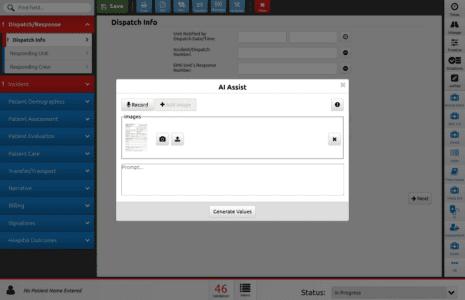When motorcyclists collide with wildlife, the consequences are often traumatic, and in Wisconsin, they happen more often than many realize. While deer and other animals are a known hazard on rural roads, a new study reveals just how frequently these encounters result in injury.
This research, conducted in collaboration with ImageTrend and the Wisconsin Office of Preparedness and Emergency Health Care, analyzed statewide EMS data and found that 24% of motorcycle injury incidents involved an animal.
But this insight wasn’t visible in the structured data alone. Instead, it required a more innovative approach—one that highlights the untapped value of EMS narrative fields in uncovering overlooked public health risks.
Going Beyond the Codes: Tapping Into EMS Narratives
Standard EMS data relies heavily on structured fields and diagnostic codes like ICD-10. Unfortunately, these codes don’t distinguish between pedestrian-related and wildlife-related crashes, leaving an information gap when it comes to animal-involved motorcycle injuries.
To bridge that gap, researchers turned to free-text narratives in EMS reports. Using keyword searches for wildlife terms, from “deer” and “bear” to more general phrases like “animal” or “critter,” the team was able to accurately identify wildlife-motorcycle collisions across five years of activations.
“EMS narratives gave us visibility into a problem that’s been difficult to quantify using traditional data sources,” said Jonathan Powell, Epidemiologist at ImageTrend. “By leveraging this often-overlooked data, we’re able to generate more actionable insights for injury prevention and system readiness.”
Key Findings: Injury Patterns and Patient Demographics
The retrospective analysis included 7,078 EMS activations for motorcycle-related injuries from 2018 to 2023. Of those, 1,695 involved a wildlife collision. Key findings included:
- Patients were more likely to be older and male in wildlife-involved crashes
- Treatment and transport rates were higher in these cases
- Seasonal trends showed predictable spikes in the warmer months, aligning with both motorcycle usage and animal movement patterns
- National data from NHTSA’s Fatality Analysis Reporting System shows that 60% of wildlife-related motor vehicle fatalities involve motorcyclists, and Wisconsin leads the nation in fatal motorcyclist crashes involving animals
These insights not only support EMS readiness but can also inform statewide public safety campaigns, road signage, and even community-level education.
Why It Matters, For Researchers and EMS Agencies
For public health agencies and research teams, this study demonstrates the critical value of unstructured EMS data. Patient care narratives, when properly analyzed, can reveal patterns that structured codes often miss, especially in emerging or underreported injury types.
For EMS agencies, it’s a reminder that good documentation has ripple effects beyond the scene. Narrative fields, validation tools, and flexible software features all contribute to a larger ecosystem of data-driven prevention.
Turning Insights Into Action: Supporting Real-Time Crash Prevention
This research also aligns with ImageTrend’s broader mission to support injury prevention through better data access and actionable insights. In addition to retrospective research like this study, ImageTrend is also powering real-time efforts to reduce transportation injuries through national collaborations.
The Transportation Incident Visualization (TIV) initiative—a joint project with NHTSA, NEMSIS TAC, and participating states—uses near real-time EMS data to highlight high-risk crash areas, behavioral trends, and injury characteristics. These dashboards support proactive decision-making and help states plan smarter roadway safety interventions.
Together, initiatives like the TIV and this motorcycle wildlife injury study represent a growing opportunity to use EMS data for early warning, prevention, and public health advancement.
Partner with the Clinical & Research Services Team
This study is just one example of how ImageTrend’s Clinical & Research Services team is helping public health and EMS leaders turn data into discovery.
From injury surveillance and health equity research to system performance studies and collaborative publications, our team can help you ask smarter questions and find better answers.
Interested in partnering on a future project? Get in touch with our research team.




